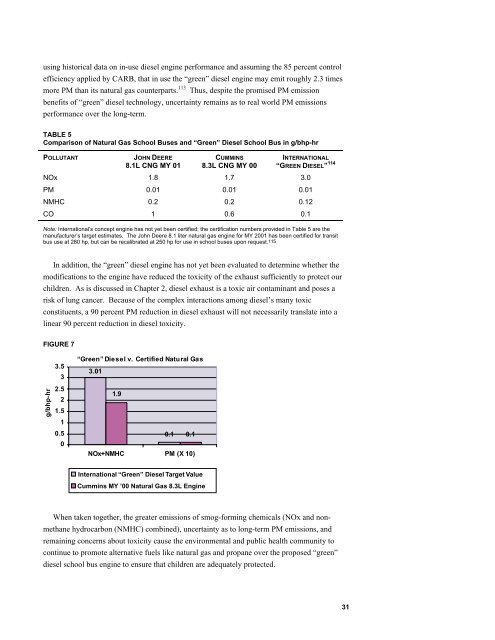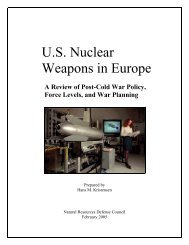NRDC: No Breathing in the Aisles: Diesel Exhaust Inside School ...
NRDC: No Breathing in the Aisles: Diesel Exhaust Inside School ...
NRDC: No Breathing in the Aisles: Diesel Exhaust Inside School ...
You also want an ePaper? Increase the reach of your titles
YUMPU automatically turns print PDFs into web optimized ePapers that Google loves.
us<strong>in</strong>g historical data on <strong>in</strong>-use diesel eng<strong>in</strong>e performance and assum<strong>in</strong>g <strong>the</strong> 85 percent control<br />
efficiency applied by CARB, that <strong>in</strong> use <strong>the</strong> “green” diesel eng<strong>in</strong>e may emit roughly 2.3 times<br />
more PM than its natural gas counterparts. 113 Thus, despite <strong>the</strong> promised PM emission<br />
benefits of “green” diesel technology, uncerta<strong>in</strong>ty rema<strong>in</strong>s as to real world PM emissions<br />
performance over <strong>the</strong> long-term.<br />
TABLE 5<br />
Comparison of Natural Gas <strong>School</strong> Buses and “Green” <strong>Diesel</strong> <strong>School</strong> Bus <strong>in</strong> g/bhp-hr<br />
POLLUTANT JOHN DEERE<br />
8.1L CNG MY 01<br />
CUMMINS<br />
8.3L CNG MY 00<br />
INTERNATIONAL<br />
“GREEN DIESEL” 114<br />
NOx 1.8 1.7 3.0<br />
PM 0.01 0.01 0.01<br />
NMHC 0.2 0.2 0.12<br />
CO 1 0.6 0.1<br />
<strong>No</strong>te: International’s concept eng<strong>in</strong>e has not yet been certified; <strong>the</strong> certification numbers provided <strong>in</strong> Table 5 are <strong>the</strong><br />
manufacturer’s target estimates. The John Deere 8.1 liter natural gas eng<strong>in</strong>e for MY 2001 has been certified for transit<br />
bus use at 280 hp, but can be recalibrated at 250 hp for use <strong>in</strong> school buses upon request.115<br />
In addition, <strong>the</strong> “green” diesel eng<strong>in</strong>e has not yet been evaluated to determ<strong>in</strong>e whe<strong>the</strong>r <strong>the</strong><br />
modifications to <strong>the</strong> eng<strong>in</strong>e have reduced <strong>the</strong> toxicity of <strong>the</strong> exhaust sufficiently to protect our<br />
children. As is discussed <strong>in</strong> Chapter 2, diesel exhaust is a toxic air contam<strong>in</strong>ant and poses a<br />
risk of lung cancer. Because of <strong>the</strong> complex <strong>in</strong>teractions among diesel’s many toxic<br />
constituents, a 90 percent PM reduction <strong>in</strong> diesel exhaust will not necessarily translate <strong>in</strong>to a<br />
l<strong>in</strong>ear 90 percent reduction <strong>in</strong> diesel toxicity.<br />
FIGURE 7<br />
g/bhp-hr<br />
3.5<br />
3<br />
2.5<br />
2<br />
1.5<br />
1<br />
0.5<br />
0<br />
“Green” <strong>Diesel</strong> v. Certified Natural Gas<br />
3.01<br />
1.9<br />
0.1<br />
0.1<br />
NOx+NMHC PM (X 10)<br />
International “Green” <strong>Diesel</strong> Target Value<br />
Cumm<strong>in</strong>s MY ’00 Natural Gas 8.3L Eng<strong>in</strong>e<br />
When taken toge<strong>the</strong>r, <strong>the</strong> greater emissions of smog-form<strong>in</strong>g chemicals (NOx and nonmethane<br />
hydrocarbon (NMHC) comb<strong>in</strong>ed), uncerta<strong>in</strong>ty as to long-term PM emissions, and<br />
rema<strong>in</strong><strong>in</strong>g concerns about toxicity cause <strong>the</strong> environmental and public health community to<br />
cont<strong>in</strong>ue to promote alternative fuels like natural gas and propane over <strong>the</strong> proposed “green”<br />
diesel school bus eng<strong>in</strong>e to ensure that children are adequately protected.<br />
31
















